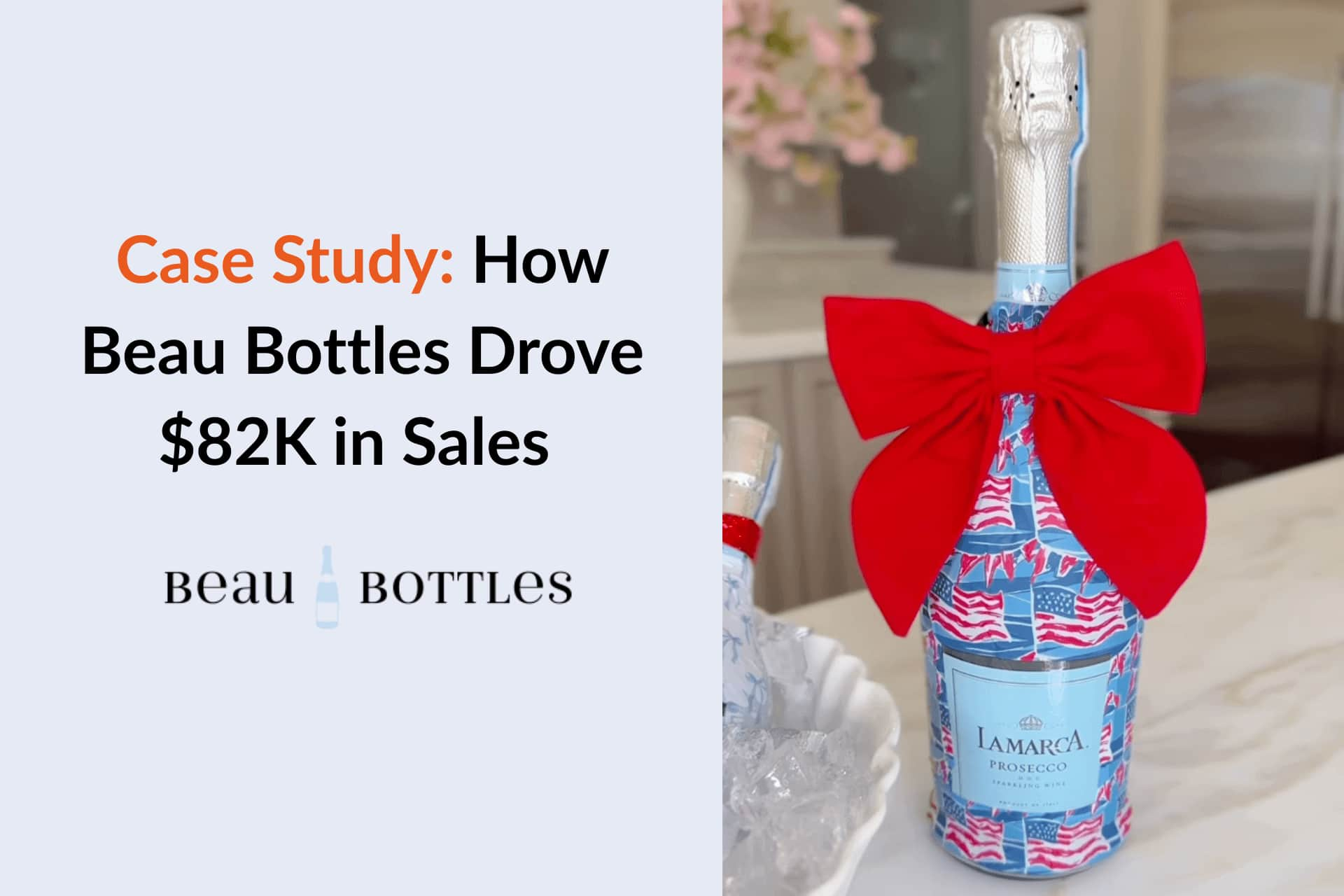





Onalytica has built a strong reputation in influencer marketing, particularly for brands in B2B industries like technology, finance, and healthcare. Its advanced influencer discovery, topical authority scoring, and dedicated Customer Success Managers make it a trusted choice for mid-market and enterprise teams seeking high-quality industry connections.
However, even strong platforms have areas where alternatives can better serve certain brands. Onalytica’s pricing is quote-only, which can be challenging for smaller budgets, its database coverage on fast-growing platforms like TikTok and YouTube is not as broad as some competitors, and the onboarding process can feel steep for teams wanting to launch campaigns quickly.
In this article, we’ll review the top 10 Onalytica alternatives so you can compare features, pricing, and reviews to find the best fit for your brand:
When evaluating Onalytica, several specific challenges stand out that often lead brands to consider alternative influencer marketing platforms. These four key pain points highlight areas where Onalytica may fall short for some users:
Onalytica supports influencer discovery across multiple channels—including Twitter, LinkedIn, Instagram, and blogs—offering a broad range of influencer types. However, some evaluations suggest that the platform’s database growth and reach on rapidly evolving platforms like TikTok and YouTube may be less comprehensive than competing tools. This could limit options for brands seeking extensive influencer pools across all major social media channels.
While Onalytica offers robust influencer identification and analytics, its capabilities for tracking direct conversions and attributing sales remain underdeveloped. This can challenge efforts to measure precise campaign ROI and optimize marketing spend.
Onalytica does not publicly disclose pricing, which complicates budgeting and cost planning. Additionally, the platform’s pricing structure may present affordability challenges for smaller businesses or startups.
The onboarding process requires time and training before teams can use the platform effectively, which might delay campaign launch. Additionally, some reporting features deliver dense, complex data presentations that can slow insight extraction.
Our comparison focuses on several key aspects:
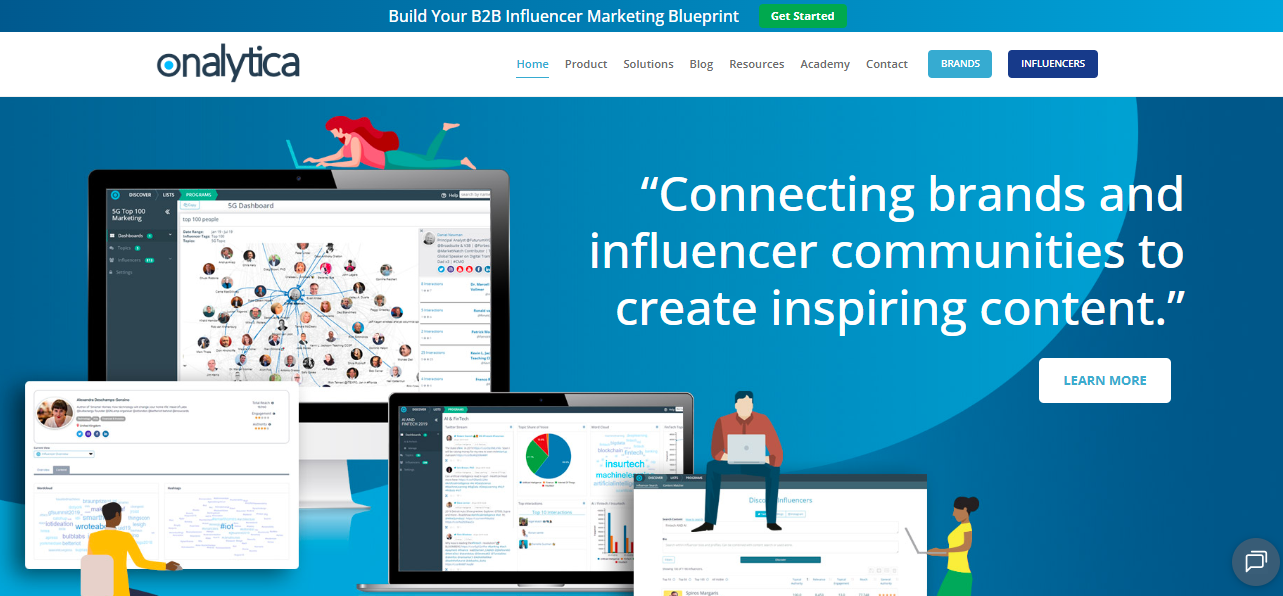
Best For: Onalytica is best for mid-market and enterprise brands—particularly in B2B industries like technology, finance, and healthcare—looking for deep influencer discovery, analytics, and relationship management combined with dedicated Customer Success support.
Platform Coverage:
Pricing: Pricing is not publicly listed, and contracts are generally annual.
Onalytica uses a custom quote-based pricing model, with costs tailored to the number of users and influencers tracked. All plans include a dedicated Customer Success Manager (CSM), and larger programs pay more for expanded features and managed services.
Reviews: 4.4 / 5.0 (Capterra)
Ease of Use (UX/UI): Users note that Onalytica’s UI is functional but not the most modern, with some visuals described as basic. The platform can be “not always intuitive” for first-time users, and onboarding sessions with the CSM are often necessary to get the most out of its advanced features. Once learned, the discovery and analytics tools are powerful, particularly for B2B research.
Customer Support: Customer support is consistently praised, with every client assigned a dedicated CSM who offers strategic guidance, onboarding assistance, and reporting support. Users value the personalized help and proactive communication, noting that the support team is responsive and knowledgeable.
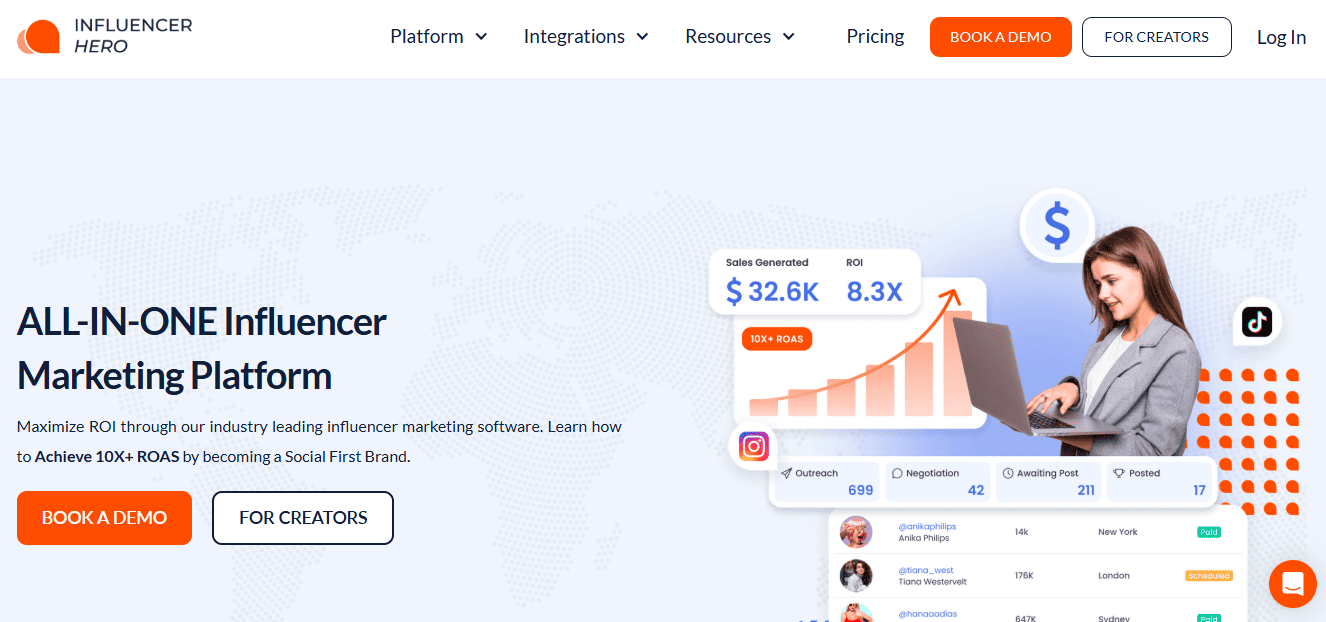
Best For: Influencer Hero is best for D2C and eCommerce brands—from emerging startups to large-scale enterprises—looking to manage influencer marketing campaigns end-to-end with built-in automation, deep analytics, and multi-platform support to maximize ROI.
Platform Coverage:
Pricing: Influencer Hero offers flexible pricing plans to accommodate growing brands. All plans include core features and can scale as the influencer program grows.
Reviews: 5.0 / 5.0 (Capterra)
Ease of Use (UX/UI): Influencer Hero is known for its clean, intuitive interface and streamlined dashboard that allows users to navigate quickly without a steep learning curve. Automated workflows, drag-and-drop campaign boards, and customizable email templates make managing campaigns faster and more efficient.
Customer Support: Customer support is one of Influencer Hero’s strongest assets. The platform delivers 24/7 real-human live chat, responsive email support, and a comprehensive Help Center with detailed guides and video tutorials. Every plan includes a dedicated account manager from day one, with optional strategy consultations for campaign growth. Pro plan users also gain access to a private Slack channel for instant, ongoing support.
While Onalytica focuses heavily on B2B influencer discovery and analytics with an enterprise service model, Influencer Hero offers a true all-in-one influencer marketing platform with CRM, automated outreach, gifting, UGC collection, affiliate payments, and storefront creation—all in a single system.
A major difference is pricing transparency: Onalytica uses a quote-only annual contract model geared toward larger enterprises, while Influencer Hero offers clear monthly plans starting at $649, making it more accessible for small and mid-sized brands without sacrificing advanced capabilities.
In terms of support, both provide dedicated account managers, but Influencer Hero’s 24/7 live chat, email, Slack access, and hands-on onboarding make it especially appealing to teams that want immediate, always-on assistance. For brands seeking versatility, faster onboarding, and predictable pricing, Influencer Hero holds a significant advantage.

Best For: Modash is best for eCommerce brands, especially Shopify stores, looking for a large-scale influencer discovery platform with advanced filtering, AI-powered search, and built-in affiliate tracking to run high-volume campaigns efficiently.
Platform Coverage:
Pricing: There are different plans and options.
Reviews: 4.7/5 (G2)
Ease of Use (UX/UI): Users highlight Modash’s clean and intuitive design, making it easy to filter through millions of profiles and set up campaigns without steep onboarding. The search and AI discovery tools are especially praised for their speed and accuracy, while the Shopify integration allows gifting and affiliate setup in just a few clicks. However, some note that managing contracts and usage rights outside the platform adds extra steps.
Customer Support: Modash is well-regarded for its responsive and knowledgeable support team, offering onboarding assistance and quick responses through email and in-platform chat. Users appreciate the direct, personal help they receive, especially when setting up campaigns or troubleshooting integrations.
Onalytica focuses on enterprise B2B influence, offering advanced topical authority scoring, custom reporting, and dedicated strategic services. It’s better suited for large organizations running thought-leadership campaigns and willing to invest in a premium, quote-based annual contract.
Modash, in contrast, caters more to eCommerce and direct-to-consumer brands—especially those on Shopify—seeking fast influencer discovery, automated gifting, and built-in affiliate tracking. Pricing is transparent, starting at $199/month (billed annually), which makes it far more accessible for SMBs and brands scaling their influencer programs without a long-term enterprise commitment.
For teams prioritizing enterprise-grade analytics, managed services, and B2B influencer relationships, Onalytica is the stronger choice. But for brands wanting affordable, high-volume creator discovery, eCommerce integrations, and affiliate automation, Modash offers a more streamlined and cost-effective solution.

Best For: Sprout Social is best for enterprise brands and agencies running large-scale influencer campaigns that require advanced analytics, competitive benchmarking, and integrated gifting/affiliate tracking through Shopify.
Platform Coverage:
Pricing & Commitment: Pricing varies depending on every brand's needs.
Reviews: 4.5 / 5.0 (Capterra)
Ease of Use (UX/UI): Users describe Sprout Social’s interface as polished and professional, with powerful filters and dashboards that allow in-depth campaign tracking. However, its broad feature set can mean a learning curve, especially for those new to enterprise-grade influencer platforms. Once onboarded, the workflow is smooth, with customizable views and centralized data access.
Customer Support: Sprout Social is praised for its responsive and knowledgeable customer support team, offering guidance on platform features and best practices. Many users highlight the proactive nature of their account managers, who help brands set up campaigns and optimize reports for strategic decision-making.
Onalytica excels in B2B influencer discovery with its topical authority scoring, global industry coverage, and deep context for niche thought leaders. However, it operates on a quote-only pricing model and can have a steeper learning curve, making it less transparent and potentially slower to adopt for smaller teams.
Sprout Social, by contrast, positions itself as a B2C and enterprise-friendly platform with a strong emphasis on brand safety, campaign workflows, competitive benchmarking, and eCommerce integration through Shopify. Pricing is public but high—starting at $1,599 per user/month with a 12-month contract—making it best suited for larger budgets.
Brands should choose Onalytica if they want deep B2B influencer intelligence and custom-managed services, and Sprout Social if they prioritize integrated campaign execution, competitive insights, and direct eCommerce tracking in a single platform.

Best For: Upfluence is best for eCommerce brands, especially those on Shopify or Amazon, looking for an end-to-end influencer marketing platform with integrated sales tracking, affiliate programs, and automated outreach.
Platform Coverage:
Pricing:
Reviews: 4.5/5 (G2)
Ease of Use (UX/UI): Users find Upfluence’s interface robust and feature-rich, offering clear campaign tracking and detailed influencer data. However, its extensive toolset can present a learning curve for beginners, especially during initial setup. Once familiar, brands appreciate the streamlined workflows and centralization of search, outreach, and payments in one place.
Customer Support: Upfluence receives positive feedback for its dedicated account support, offering onboarding guidance and campaign optimization tips. Many users highlight the team’s responsiveness in troubleshooting integration issues, particularly with Shopify and Amazon, and in helping brands maximize ROI from existing customer collaborations.
Onalytica is geared toward B2B influencer marketing with deep topical authority scoring, strong industry-specific influencer coverage, and dedicated Customer Success Managers. Its enterprise-focused approach and custom pricing make it appealing for brands that prioritize thought-leadership campaigns, relationship building, and strategic influencer identification over transactional eCommerce-driven campaigns.
Upfluence, on the other hand, is highly eCommerce-centric, offering Shopify and Amazon integrations that enable direct sales attribution, affiliate management, and customer-influencer identification. Pricing is transparent—starting at $1,276/month—and while it’s still an investment, brands know their costs upfront. The inclusion of AI-powered outreach and full campaign execution tools makes it more of an all-in-one operational hub for D2C brands.
Choose Onalytica if you need B2B discovery depth, global industry reach, and managed services, and Upfluence if your focus is driving measurable eCommerce sales, scaling affiliate programs, and automating influencer outreach in a single platform.

Best For: Captiv8 is best for large enterprise brands and agencies seeking deep influencer analytics, competitive tracking, and collaborative campaign management at scale, with the budget to invest in premium features like storefronts and affiliate commerce programs.
Platform Coverage:
Pricing: There are different pricing options:
Reviews: 4.1/5 (G2)
Ease of Use (UX/UI): Users appreciate Captiv8’s powerful search filters, customizable reports, and intuitive campaign collaboration tools that make it easy for large teams to coordinate. The drag-and-drop report builder and filter locking save time when running recurring searches. However, its vast feature set can be overwhelming at first, and some users note that it’s clearly built for enterprise-scale campaigns rather than smaller, agile teams.
Customer Support: Feedback on customer support is mixed. While some enterprise clients report responsive assistance, numerous public reviews — especially from Reddit — highlight unresponsive support, unresolved account issues, and payment delays for both brands and creators. This inconsistency has been flagged as a significant drawback for brands that need dependable, ongoing support.
Onalytica specializes in B2B influencer discovery and relationship management, with proprietary topical authority scoring, global industry coverage, and dedicated CSM support. It’s ideal for brands focused on thought-leadership and niche influencer targeting, especially when personalized strategic guidance is a priority. Pricing is quote-based, making it harder for smaller teams to plan budgets upfront.
Captiv8, on the other hand, is built for large-scale B2C and enterprise influencer campaigns with a focus on competitive intelligence, deep performance analytics, and collaborative workflows. Pricing is transparent but steep—starting at $25K annually plus onboarding, with additional enterprise add-ons like storefronts costing $20K–$30K/month. This positions Captiv8 as a solution for brands with substantial budgets and a need for advanced, multi-team campaign execution.
Choose Onalytica if you need deep B2B influencer intelligence and personalized service, and Captiv8 if you’re running large consumer-facing campaigns that require robust analytics, competitive tracking, and multi-team collaboration at scale.

Best For: Enterprise and mid-market brands across industries looking for a full end-to-end influencer marketing solution that covers discovery, campaign management, payments, and reporting — with strong API integrations and global platform coverage.
Platform Coverage:
Pricing: There are different plans:
Reviews: 4.7/5 (G2)
Ease of Use (UX/UI): Users describe CreatorIQ’s interface as clean, data-rich, and professional, with powerful filters that make influencer search precise. While the depth of features can require some onboarding, once familiar, most teams find campaign setup, reporting, and CRM functions straightforward and efficient. The live-link sharing and executive-ready visuals make it easy for stakeholders to review results without logging in.
Customer Support: CreatorIQ customers consistently praise the platform’s onboarding process, strategic input, and responsiveness. Each account includes a dedicated implementation manager and customer success team, ensuring smooth setup, quarterly planning, and hands-on campaign strategy support. Many users highlight that the team feels like an extension of their own marketing department.
Onalytica has a strong B2B focus, excelling in topical authority scoring, deep influencer network mapping, and tailored professional services. Its pricing is quote-based and often best suited for large, complex programs, especially in sectors like technology, finance, and healthcare. However, its learning curve and lack of native in-platform messaging may be a drawback for teams seeking faster onboarding and all-in-one functionality.
CreatorIQ, on the other hand, is built for full lifecycle influencer marketing across B2C and B2B campaigns, with strong integrations to all major social platforms and robust tools for discovery, CRM, campaign management, payments, and reporting. It offers annual plans typically ranging from $2K–$5K/month for its Basic or Standard tiers, plus optional add-ons like branded creator sign-up pages.
For brands seeking a single platform to manage everything end-to-end with top-tier API data accuracy, CreatorIQ may be the better fit, while Onalytica appeals more to those prioritizing niche authority discovery and custom insights over integrated execution.

Best For: Brands and agencies seeking in-depth influencer analytics and fraud detection, alongside robust discovery, outreach, and campaign tracking — particularly those that value AI-powered search and customizable pricing models.
Platform Coverage:
Pricing: HypeAuditor’s pricing is customizable, with the standard “Business” plan starting at around $10,000/year. Pricing can be adjusted based on the number of reports, active campaigns, and platform usage. They also offer a 24–48 hour free trial for new users.
Reviews: 4.6/5 (G2)
Ease of Use (UX/UI): Users report that HypeAuditor’s interface is modern and data-rich, with advanced filtering options that make influencer discovery highly precise. While its depth of features offers strong flexibility, beginners may require onboarding or training to unlock the platform’s full potential. Once familiar, the workflow from discovery to campaign reporting is smooth and intuitive.
Customer Support: HypeAuditor is praised for responsive and helpful support, with onboarding assistance included in all plans. Their team offers guidance during setup, training, and ongoing campaigns, helping brands get the most out of features like AI-powered discovery and fraud detection. The availability of a free trial also lets users test the platform with support before committing.
Onalytica is heavily positioned toward B2B influence, focusing on topical authority scoring, deep network mapping, and enterprise-grade managed services. Its pricing is quote-based, making it less accessible for SMBs and more aligned with larger organizations that require tailored strategy support and dedicated CSMs.
HypeAuditor, on the other hand, has a broader appeal across B2C and B2B, with a strong emphasis on influencer authenticity verification, fraud detection, and eCommerce integration. It offers a transparent starting point for its Business plan (around $10K/year) and includes a free trial, making it easier to evaluate before committing.
While Onalytica shines in niche B2B targeting and custom insights, HypeAuditor is a better fit for brands that want AI-powered search, built-in outreach tools, and robust analytics with Shopify integration for measurable sales attribution.

Best For: E-commerce and DTC brands looking to manage influencer programs end-to-end — from discovery and gifting to affiliate tracking, UGC collection, and payments — with deep native integrations to Shopify, WooCommerce, Magento, and PayPal.
Platform Coverage:
Pricing:
Reviews: 4.5 / 5.0 (G2)
Ease of Use (UX/UI): Users say GRIN’s interface is intuitive for brands already familiar with e-commerce workflows, with everything from creator search to payments centralized in one dashboard. The integrated product seeding, campaign CRM, and content library make day-to-day execution straightforward. However, some reviews note occasional performance issues such as slow loading or glitches that can interrupt workflow.
Customer Support: GRIN offers onboarding assistance, optional program strategists, and ongoing customer success support. Many customers appreciate the helpfulness and strategic input from GRIN’s team, though some have experienced delayed responses or unresolved tickets during busier times. Brands that opt for dedicated strategists tend to report smoother campaigns and better ROI tracking.
Onalytica excels in B2B influencer discovery, powered by topical authority scoring and network mapping, making it ideal for brands in sectors like tech, finance, and healthcare. Its strengths lie in insight depth and strategy support via dedicated CSMs, but it lacks native e-commerce integrations and has a steeper learning curve for new users. Pricing is entirely quote-based, which may not suit brands seeking clear cost visibility.
GRIN, in contrast, is purpose-built for e-commerce and DTC brands, offering robust integrations with platforms like Shopify, WooCommerce, and Magento for seamless product seeding, gifting, and affiliate sales tracking. It’s an all-in-one execution hub for influencer campaigns, from discovery to ROI reporting, with unlimited creator partnerships. While GRIN’s pricing starts higher (around $25K/year) and requires an annual commitment, it delivers strong value for brands that rely on measurable, sales-driven influencer marketing.
If your focus is complex B2B campaigns with deep analytics, Onalytica may be the better fit, but if you want end-to-end e-commerce influencer management, GRIN is the clear choice.
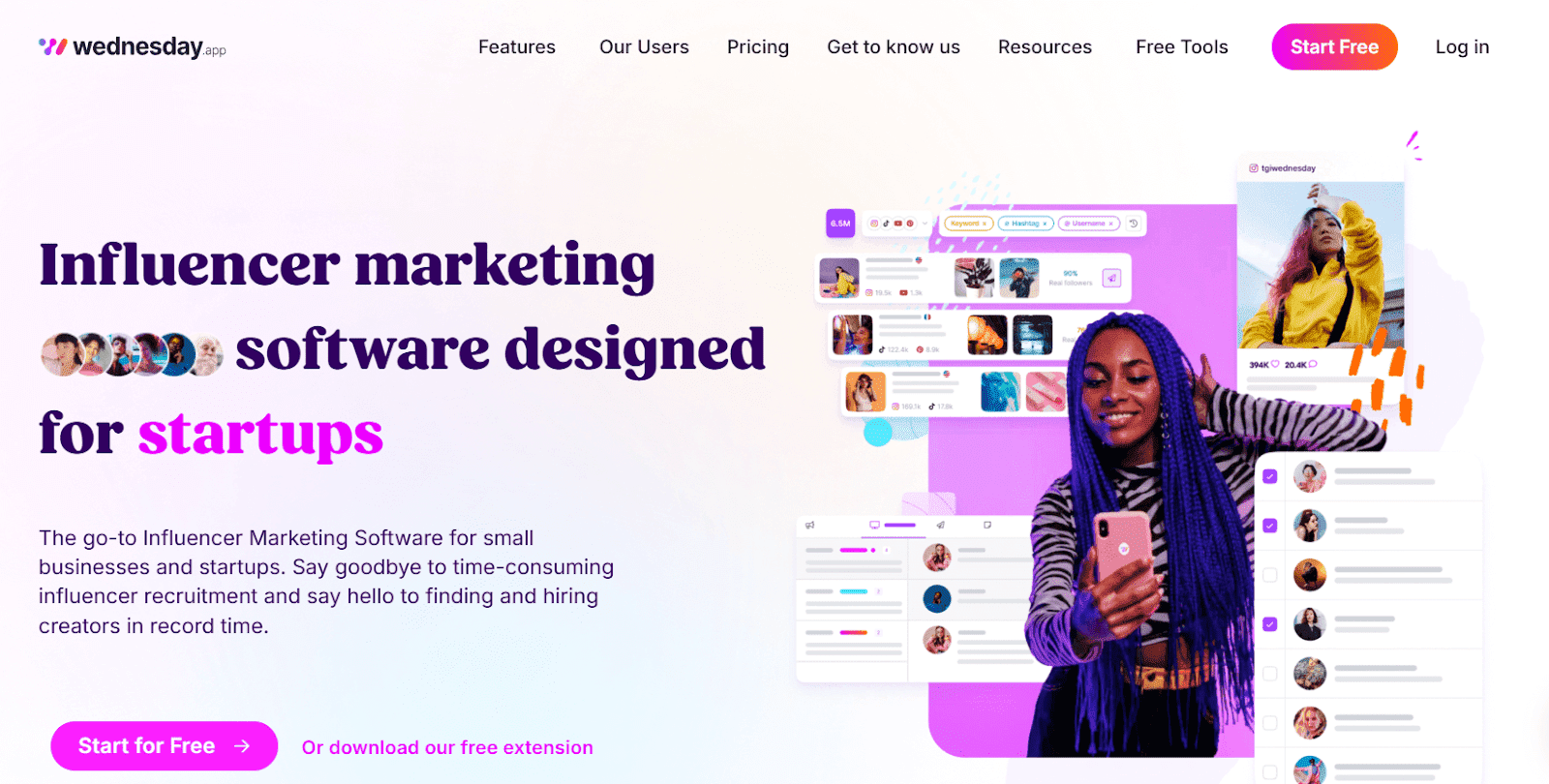
Best For: Small to mid-sized businesses and emerging brands looking for an affordable, all-in-one influencer discovery, outreach, and CRM tool without enterprise-level costs or commitment. Ideal for brands on a budget who still want AI-powered discovery and built-in messaging.
Platform Coverage:
Pricing:
Reviews: 4.6/5.0 (G2)
Ease of Use (UX/UI): Users often highlight Wednesday’s clean and intuitive interface, which removes the clutter common in enterprise-grade platforms. The streamlined layout makes it easy to move from influencer search to outreach and CRM without confusion, even for those new to influencer marketing tools. The learning curve is minimal, and features are clearly organized for quick navigation.
Customer Support: Users appreciate the platform’s approachable support team and responsive communication, especially for a lower-cost tool. While not as high-touch as enterprise services, the assistance provided is straightforward and helpful, ensuring small teams can troubleshoot issues quickly.
Onalytica is a high-end Influencer Relationship Management (IRM) platform tailored for mid-market and enterprise brands, with advanced B2B discovery features, topical authority scoring, and a dedicated Customer Success Manager for every account. Its pricing is quote-based and generally higher, reflecting its enterprise focus, custom reporting, and managed services.
Wednesday.App, in contrast, is designed for small to mid-sized businesses wanting an affordable, easy-to-use solution that still covers discovery, outreach, CRM, and reporting. With pricing starting at $79/month (and a forever free plan), it offers a low barrier to entry, making it a fit for brands just beginning influencer marketing or managing modest-scale campaigns.
In short, choose Onalytica if you need enterprise-level insights, global B2B coverage, and dedicated strategic support—and have the budget for it. Opt for Wednesday.App if you’re looking for a budget-friendly, all-in-one tool that gets you from discovery to outreach quickly, without the complexity or cost of enterprise platforms.
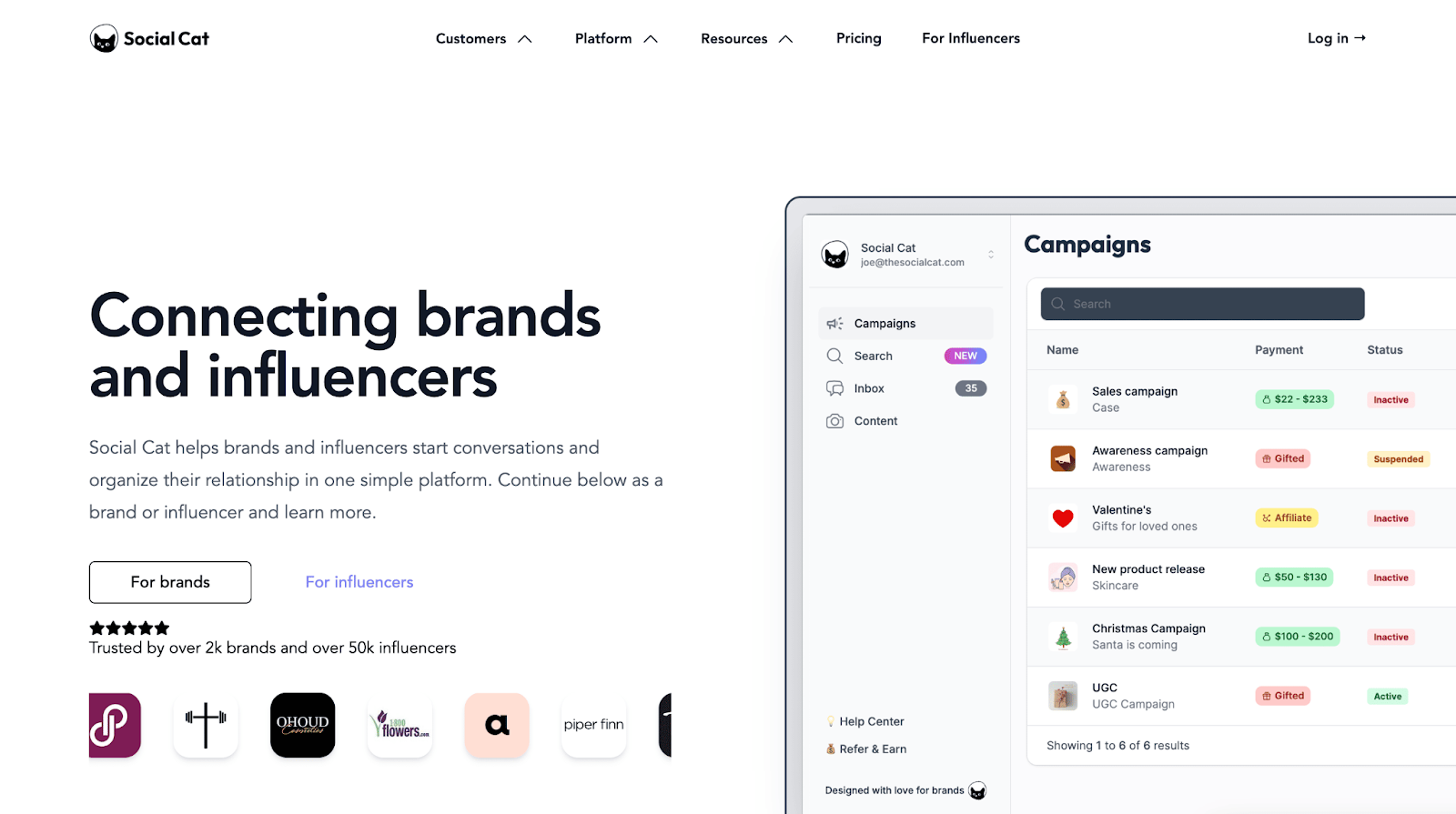
Best For: Small to medium-sized brands—especially those on Instagram and TikTok—looking for an affordable, beginner-friendly platform to manage influencer discovery, product seeding, and collaborations without complex enterprise features or costs.
Platform Coverage:
Pricing:
Review: 4.3/5.0 (Trustpilot)
Ease of Use (UX/UI): Users often praise Social Cat’s simple, streamlined interface that makes it easy for small teams to set up campaigns, filter for relevant influencers, and manage collaborations without a steep learning curve. The workflow is intuitive, with all key actions—campaign creation, messaging, contracting—accessible from one central dashboard.
Customer Support: Social Cat’s support is described as responsive and approachable, with email support included in all plans and priority support for Pro users. While it doesn’t have the high-touch account management of enterprise tools, users note that assistance is fast and straightforward, helping brands keep campaigns on track.
Onalytica is positioned as an enterprise-grade Influencer Relationship Management platform, offering advanced discovery powered by topical authority scoring, extensive B2B influencer networks, and dedicated Customer Success Managers. Pricing is quote-based, typically higher, and designed for large, complex influencer programs—making it a strong fit for mid-market and enterprise brands that need deep analytics, competitive benchmarking, and global coverage.
Social Cat, on the other hand, is built for small to medium-sized brands focused on Instagram and TikTok collaborations . Pricing starts at $99/month, with straightforward plans that include influencer applications, product seeding workflows, and built-in content usage rights. While it doesn’t offer the depth of analytics or enterprise integrations Onalytica provides, Social Cat’s simplicity and affordability make it a practical choice for brands starting influencer marketing or running smaller-scale campaigns.
In short, choose Onalytica if you need global B2B influencer insights, advanced measurement tools, and a high-touch service model. Choose Social Cat if you want a low-cost, easy-to-use platform for finding and collaborating with micro and nano influencers—especially on Instagram and TikTok—without the complexity or expense of enterprise software.
Exploring Onalytica alternatives opens up a range of powerful influencer marketing platforms that can better match your brand’s goals, budget, and workflow.
While Onalytica offers robust influencer relationship management tools, many businesses are seeking solutions that provide more flexibility, deeper analytics, or better pricing structures. From platforms that excel in influencer discovery and outreach to those focused on advanced reporting and ROI tracking, there are plenty of strong contenders to consider.
Among these, Influencer Hero stands out as one of the best alternatives, offering an all-in-one platform that covers influencer search, outreach, campaign management, product seeding, affiliate tracking, and in-depth analytics—making it a top choice for brands looking for efficiency and results in one place. Book a free demo today and experience firsthand how it compares to Onalytica!

Onalytica excels in B2B-focused influencer discovery with sophisticated topical authority scoring and customized enterprise services. In contrast, Influencer Hero offers a broader all-in-one influencer marketing platform—combining influencer search, outreach, campaign management, product seeding, affiliate tracking, and analytics into a unified experience. Influencer Hero is often more accessible for brands with streamlined needs and tighter budgets.
Onalytica typically offers quote-based pricing, tailored to enterprise-scale needs and supported by a dedicated CSM. Alternatives like Influencer Hero tend to offer more transparent, tiered pricing—often with monthly or annual plans that clearly outline included features, making budgeting and evaluation easier.
Onalytica focuses on discovery and analytics but often lacks deep native e-commerce integration. Platforms like Influencer Hero, on the other hand, prioritize e-commerce-friendly workflows, providing seamless integrations (e.g., Shopify), product seeding, affiliate tracking, and real-time ROI reporting for streamlined sales attribution.
Onalytica delivers strong discovery and insight tools, but lacks built-in CRM, outreach, and messaging capacities. Influencer Hero fills that gap by offering integrated influencer outreach, relationship tracking, content brief management, and performance monitoring within a single dashboard—making campaign management smoother and less fragmented.
Onalytica’s focus remains on network mapping and role-based discovery, without advanced fraud detection or UGC rights tools. Alternative platforms like Influencer Hero often include influencer authenticity scoring, fraud detection alerts, auto-managed content usage permissions, and a centralized content library—empowering brands to work confidently and compliantly with influencer content.



Schedule a Demo with one of our media experts below.